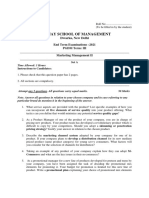0% found this document useful (0 votes)
263 views26 pagesChapter 16
The document discusses how consumers evaluate alternatives and make choices, outlining three types of choice processes - affective, attitude-based, and attribute-based. It also examines how consumers determine evaluative criteria and their importance, and outlines several decision rules consumers may use in attribute-based choices like conjunctive, disjunctive, elimination-by-aspects, lexicographic, and compensatory rules.
Uploaded by
Bo ZydarinCopyright
© © All Rights Reserved
We take content rights seriously. If you suspect this is your content, claim it here.
Available Formats
Download as PPT, PDF, TXT or read online on Scribd
0% found this document useful (0 votes)
263 views26 pagesChapter 16
The document discusses how consumers evaluate alternatives and make choices, outlining three types of choice processes - affective, attitude-based, and attribute-based. It also examines how consumers determine evaluative criteria and their importance, and outlines several decision rules consumers may use in attribute-based choices like conjunctive, disjunctive, elimination-by-aspects, lexicographic, and compensatory rules.
Uploaded by
Bo ZydarinCopyright
© © All Rights Reserved
We take content rights seriously. If you suspect this is your content, claim it here.
Available Formats
Download as PPT, PDF, TXT or read online on Scribd
/ 26

































































































